A lavender tree provides natural beauty and an intoxicating aroma. You can easily introduce one into your home or garden to add an element of nature and a pop of color! Continue reading to learn how to grow and care for a lavender tree – both indoors and outdoors!
English lavender plants are a go-to in my gardens, and potted inside my home. I love their muted gray green foliage and soft purple blooms. Beyond their beautiful blooms, the aroma they give off is heavenly.
They are so easy to maintain, that I really think every garden should have a little lavender.
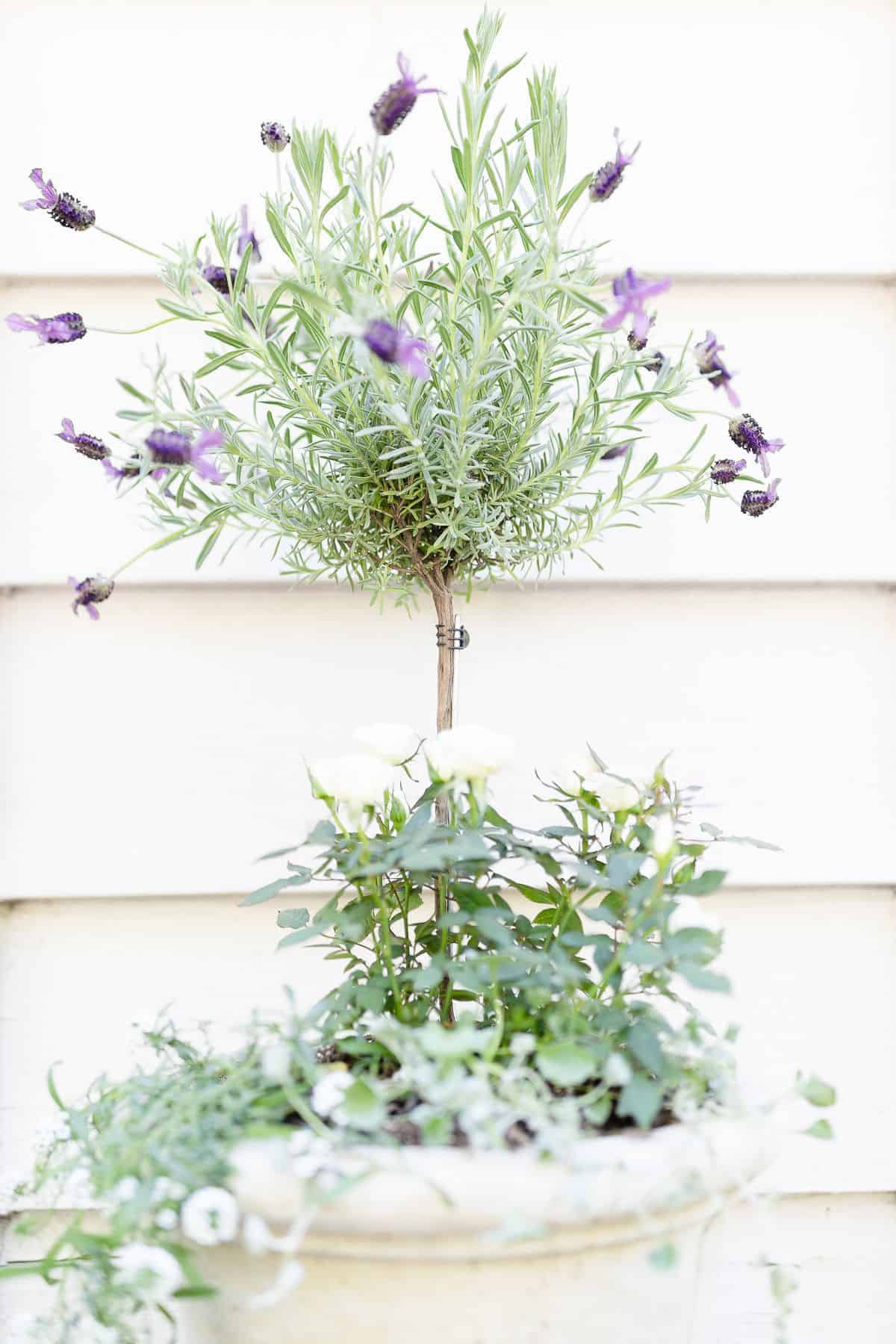
I’ve long been inspired by topiaries of all kinds. There’s just something so special about the slightly formal, graceful look and shape about them!
I love having a little herbal topiary in my kitchen near the sink, or in our summer planters. You can find rosemary, lavender and more, shaped into beautiful traditional trees.
A striking variation of a traditional English lavender or French Lavender plant is a lavender tree. It also goes by the names of lavender topiary and lavender standard topiary. With its beautiful, structured form, it adds a classic style in any home or garden.
Check out my maintenance free garden ideas to see how I incorporate lavender into my garden. These DIY galvanized planters are a fun and simple way to bring lavender to your porch. Don’t forget that others would love to receive lavender pots for gifts!
What Is Lavender?
Lavender is an herb that originated in the Mediterranean and surrounding areas. However, it grows so easily that it can thrive all over the world. It has a distinct, aromatic scent that is light and fresh. Lavender’s colors are typically a muted green and purple.
Not only is lavender beautiful and easy to grow, it is good for you, too. The scent is calming and luxurious, and is often used in bath products. I make my own lavender and lemon sugar scrub and lavender mint bath salts to highlight the fragrance and therapeutic qualities of lavender.
Dried flowers can be used in potpourri and soaps for its aroma and texture. Lavender oil has a strong scent and is used in many bath products for aromatherapy and skin benefits.
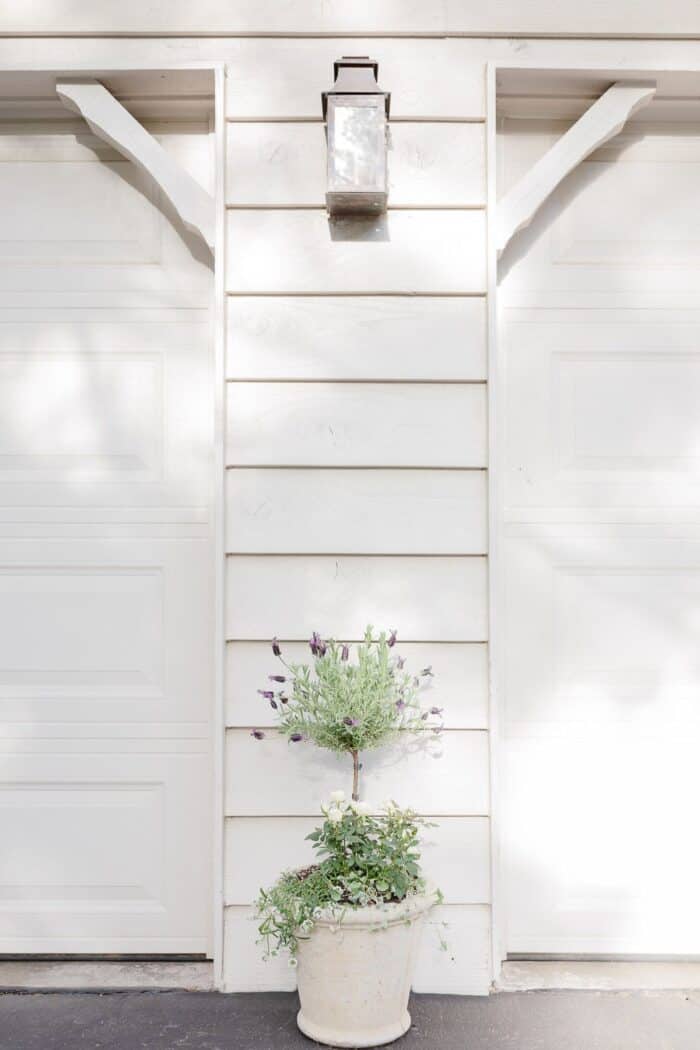
English Lavender and More Varieties
There are a lot of varieties of lavender, including English lavender, French, Spanish, and more. These varieties differ in flower color and shape, leaf color and shape, and even the scent.
English lavender varieties tend to be the most popular here in the Midwest, as they are hardy through zone five.
The most popular lavender varieties grown in the US are as follows:
- Betty’s Blue, English Lavender (Lavandula Angustifolia)
- French Lavender (Lavandula Dentata)
- Spanish Lavender (Lavandula stoechas)
- Lavenite Petite, English Lavender (Lavandula Angustifolia)
- Impress Purple, Hybrid (Lavandula x Intermedia)
- Portuguese Lavender (Lavandula Latifola)
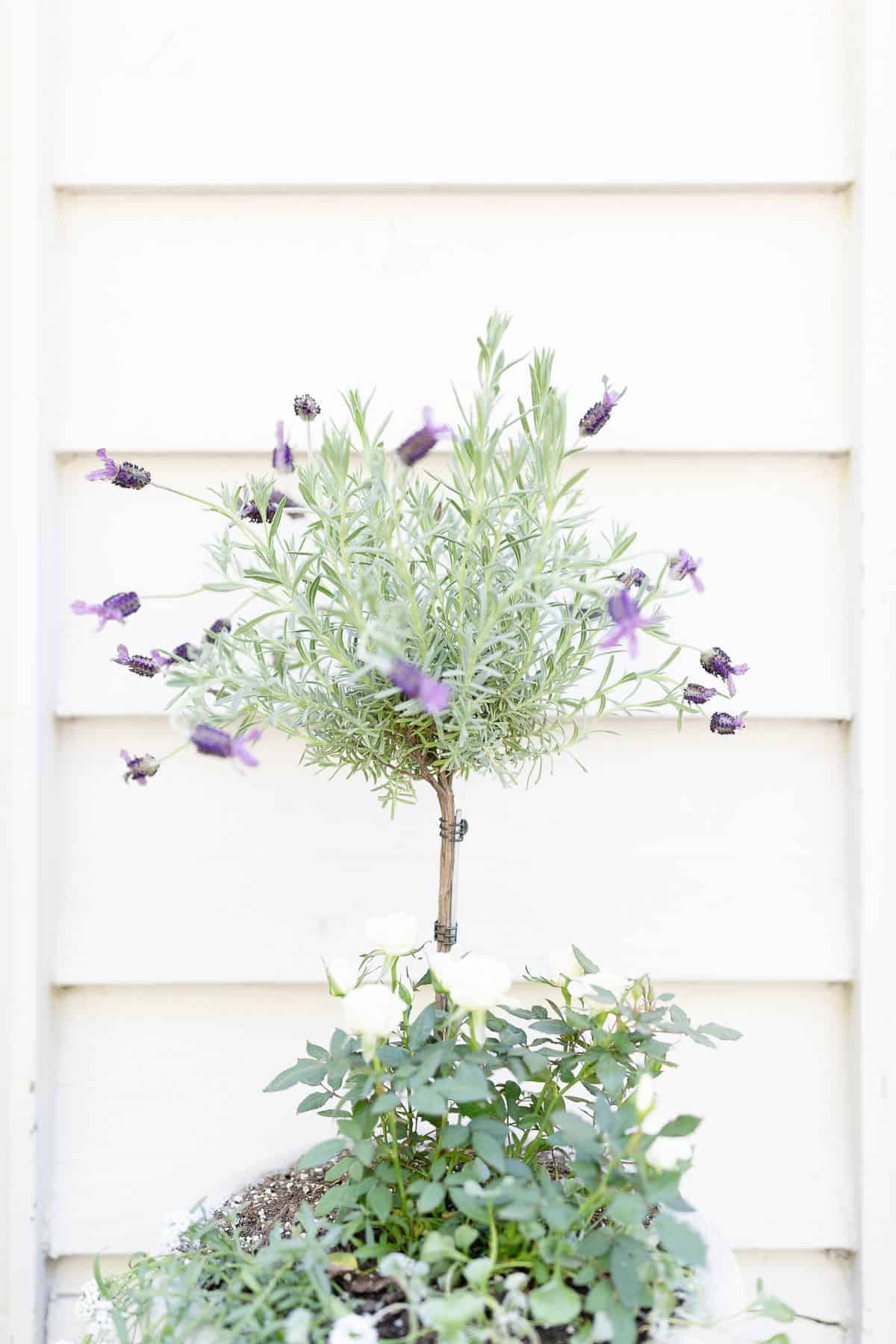
What Is a Lavender Tree?
You’re probably familiar with the classic English lavender plants that are often grown in gardens and pots, both indoors and out. Well, I’d like to introduce you to a lavender tree!
It still has the same qualities as lavender, with the lovely leaves and flowers. Yet, it takes on a whole new look with the foliage portion sitting on top of a thin trunk in topiary form.
A lavender tree is made from a plant that was trimmed and trained to grow from the top. You can buy them already formed into a tree, or patiently trim your own. The branches can grow up and rounded, or they can grow out and be more spikey. Choose the look that you love!
It stays quite petite with a height of 2-3 feet. However, if it is housed in a pot, it can appear a bit taller than that. The width can be up to 2 feet, or you can cut it back to keep it more in proportion with the height.
Lavender trees look really nice in pots that are placed indoors or on a patio. Choose a pot or basket that suits your style and place the basic pot the tree came in inside of your preferred pot or basket.
They can also be planted in raised beds and right into a garden. They have such a cute and simple look!
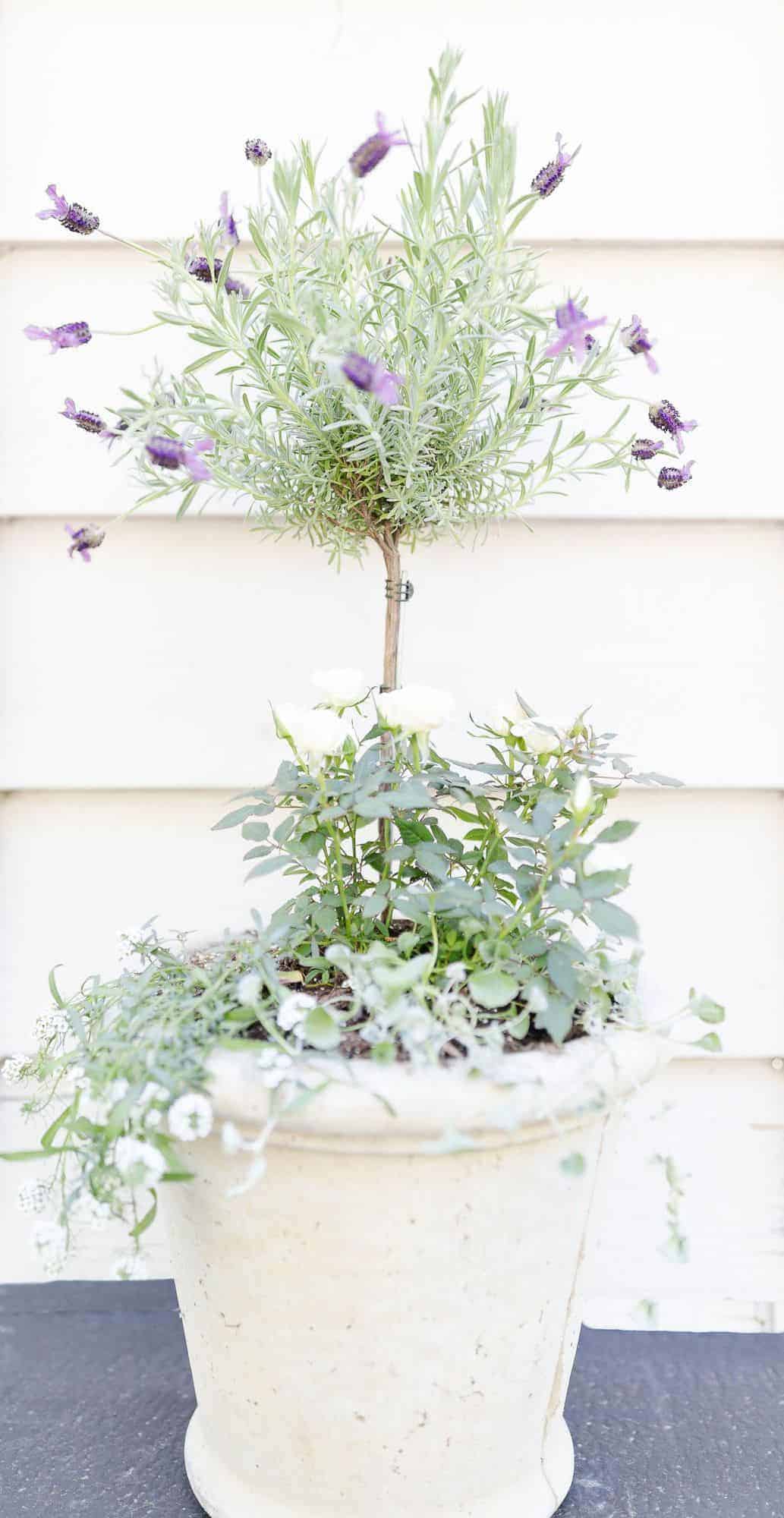
How to Care for a Lavender Tree
Since this plant is native to a rugged climate, it tends to be quite hardy. Most lavender is grown outside, but can also be grown inside. It will perform well for you if you follow a few steps.
Growing Lavender Indoors
Choose a pot that is no more than 2 inches wider than the root ball. This keeps the soil from staying too wet and potentially causing root rot. Add some rocks at the bottom of the pot to help with drainage. Water whenever the top 1-2 inches of the soil are dry.
Place pot on a removable tray or plate so that the pot won’t sit in excess water. If you want a larger pot, place your smaller pot inside a larger container. This is nice because you can choose a larger pot that matches your decor.
Use a nice fertilized soil when you plant your lavender tree. Add a little agricultural lime to the soil for lavender to grow.
Place your lavender tree on the floor, on a table, or any other place that allows it to receive plenty of sunshine during the day. Avoid placing it near a cold or warm air draft, though.
Lavender trees will be especially happy if you allow them to live outside during the summer. They can absorb the sun and nutrients they need to grow correctly before you bring them in for the winter.
Outdoor Lavender Trees
Lavender trees like a lot of sun, around 6 hours each day. They also need soil that drains well. Dig a hole that is twice as big as the root ball. Place the plant inside the hole and fill with dirt to cover the roots.
Allow the soil to dry out between waterings. You can tell if it is dry enough by feeling into the soil 1-2 inches. If the soil is dry, then it is time to water.
Lavender thrives outside when it can get all the sunlight it needs. Bees are attracted to the flowers and naturally pollinate the plant.
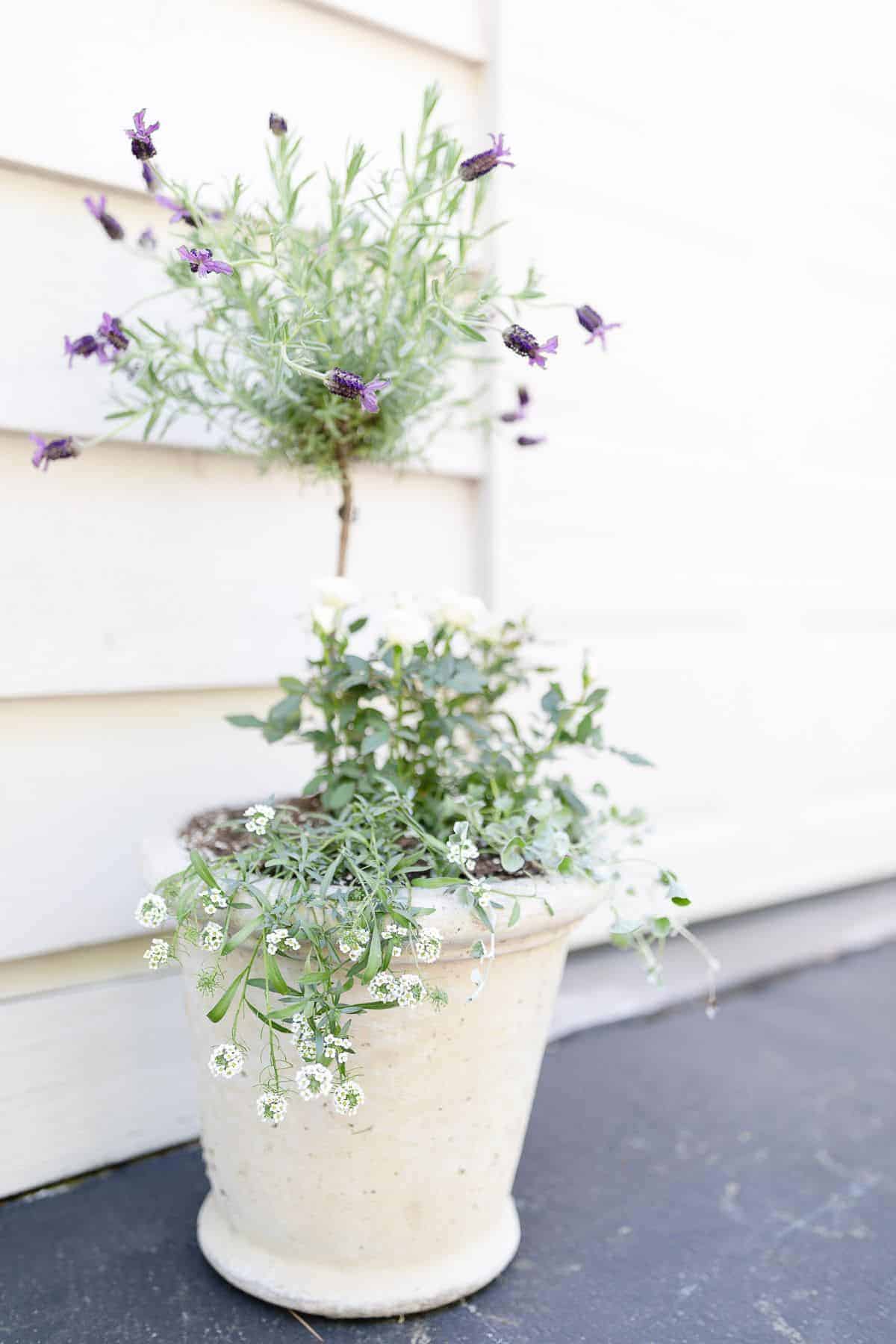
Frequently Asked Questions
In zones 7-10, lavender trees can stay outdoors, planted in the ground. However, in colder climates, they need to be brought indoors over the winter.
Other types of lavender, like English lavender, are generally more cold hardy and can come back every year when planted in your garden.
A lavender tree will generally remain quite petite in growth, with a height of 2-3 feet. However, if it is housed in a pot, it can appear a bit taller than that. The width can be up to 2 feet at the top depending on trimming and training.
Yes! With a few simple care steps and the right lighting and temperature conditions, it’s very possible to grow lavender indoors.
At best, you’ll likely be able to keep your lavender tree alive for 4-5 years. They tend to become leggy and more difficult to shape by that time, with their woody stems becoming hardened and tired.
Regular pruning is important for lavender plants. Without regular pruning the woody stems can get leggy and the plants will stop blooming.
Lavender likes full sun with well drained, sandy soil with a bit of an alkaline blend that you can add with a touch of lime.
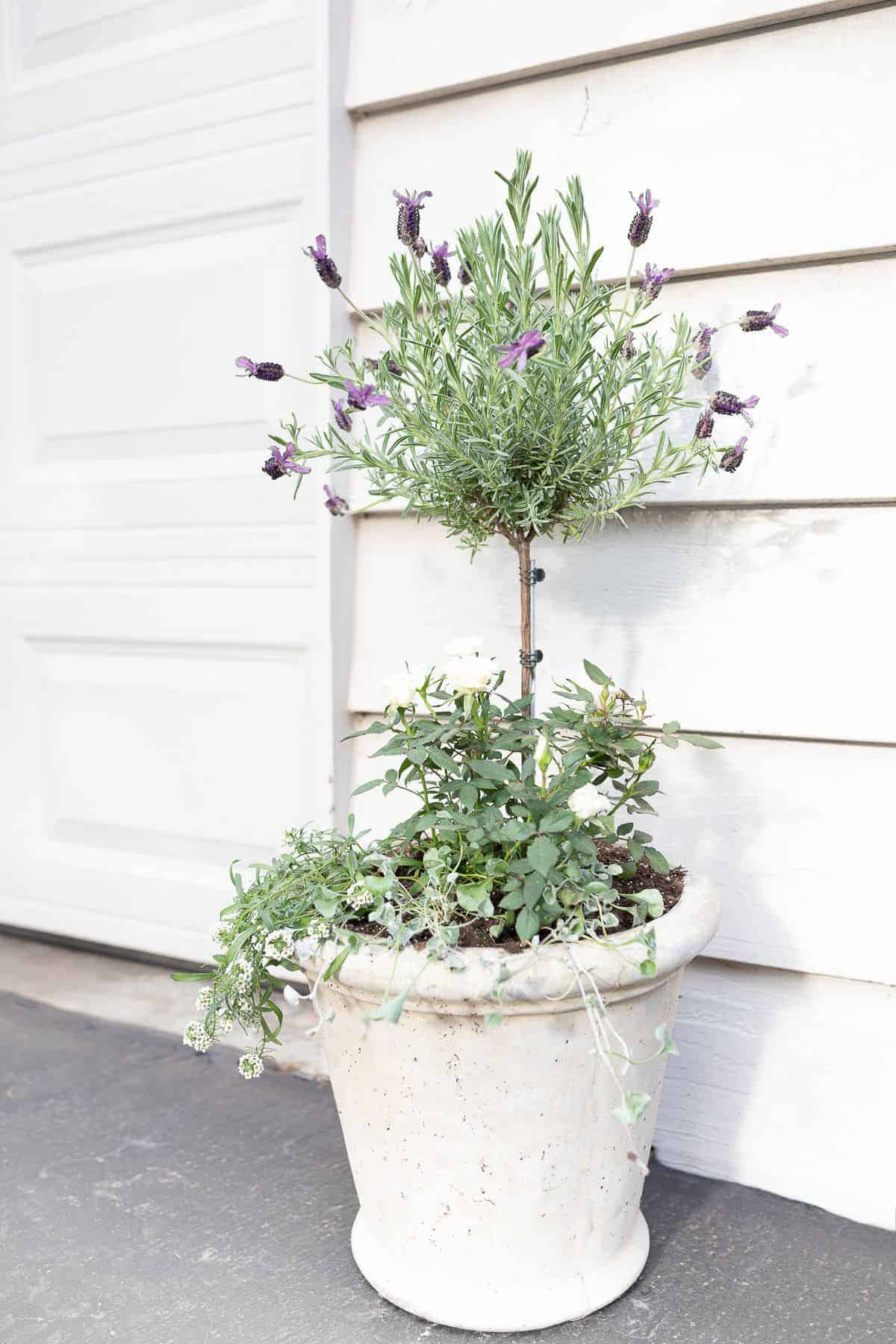
I’m pretty sure that you’ll be successful if you decide to grow a lavender tree! I hope you love it as much as I do!
Sources
Because it’s a common question I receive, these planters were filled with miniature white roses, white sweet Alyssum and Silver Falls Dichondra at the base of the lavender topiary.
- 18″ Live Lavender Topiary ($38+ shipping)
- 12″ Lavender Tiny Topiary ($28+ shipping)
- These particular pots are discontinued, but you can find similar options below and in my Amazon storefront, above!
Join Our Community
Let’s keep in touch! Receive exclusive content, including never-seen-before photos, our favorite home decor DIYs and more!
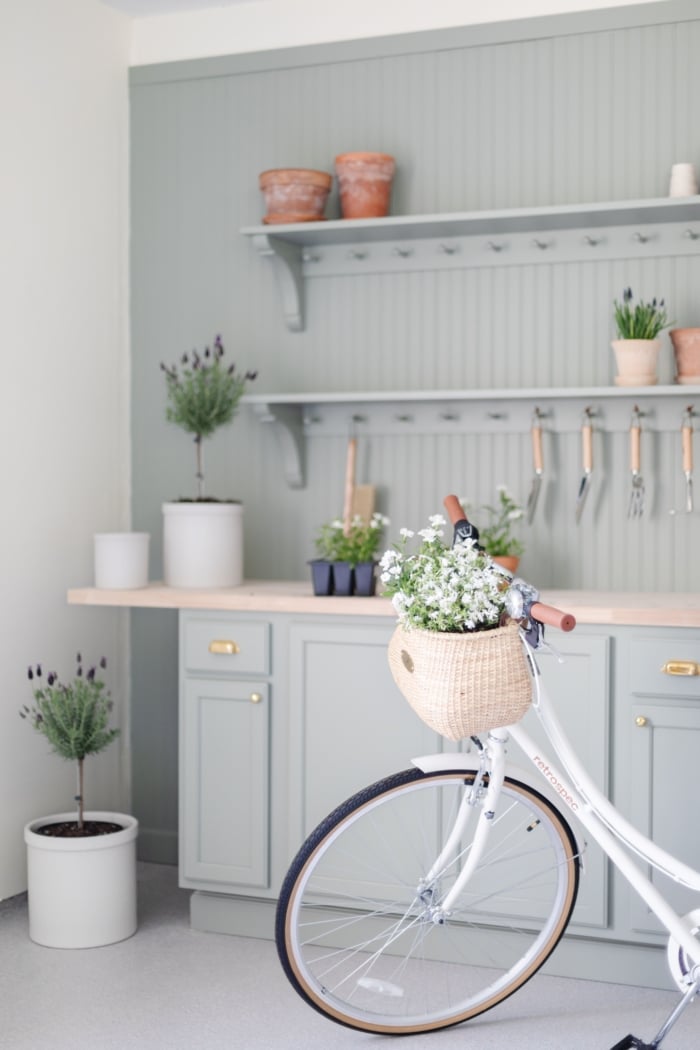
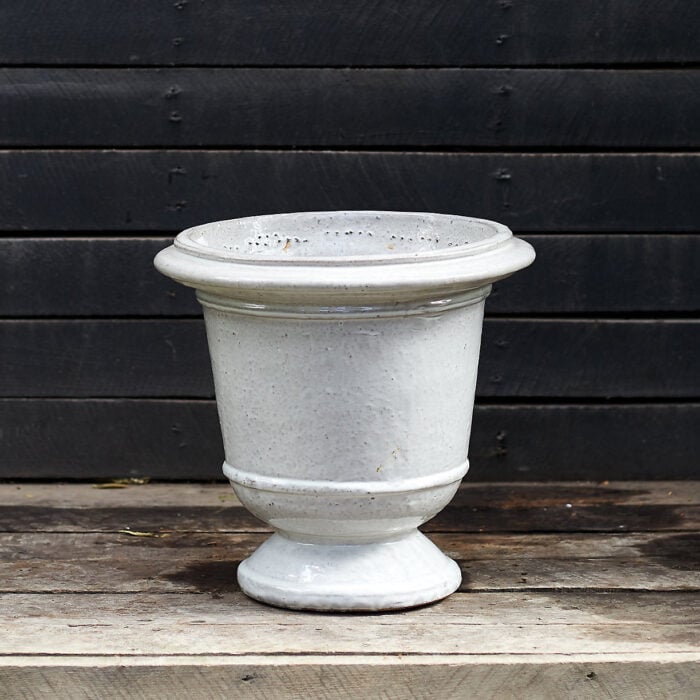
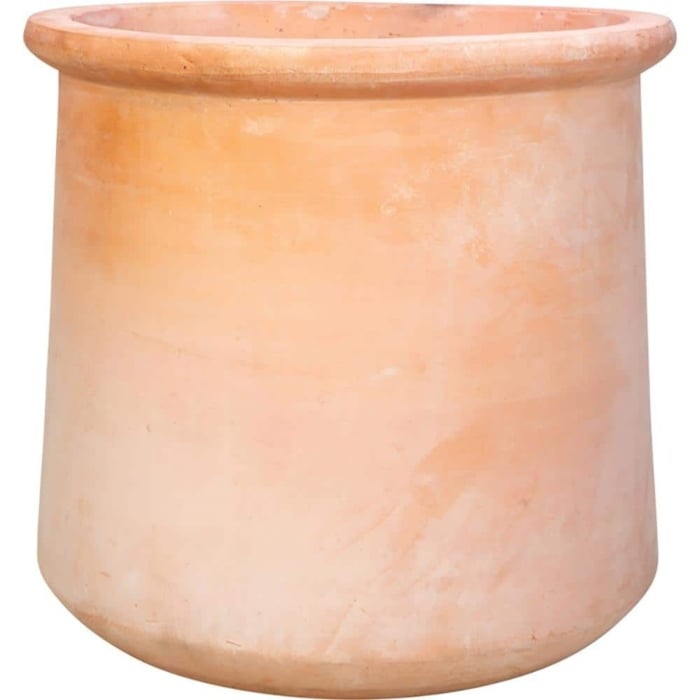
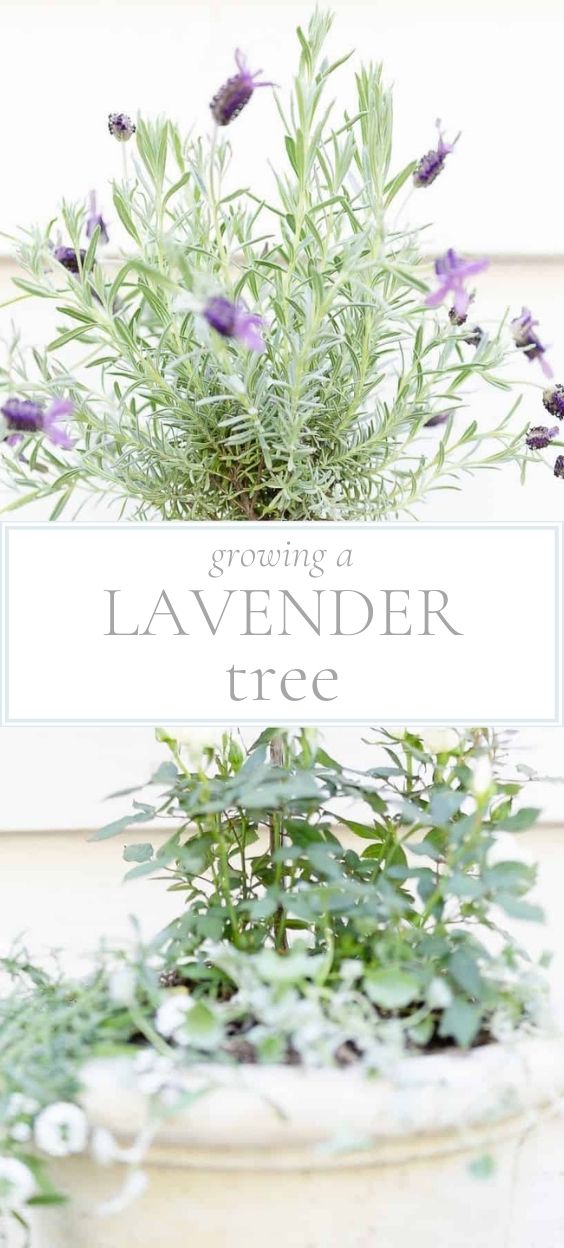
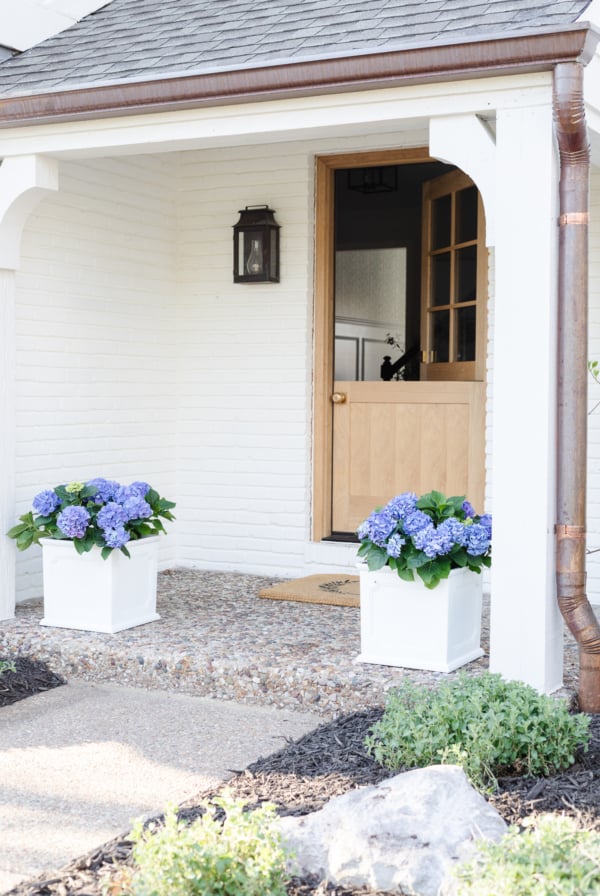

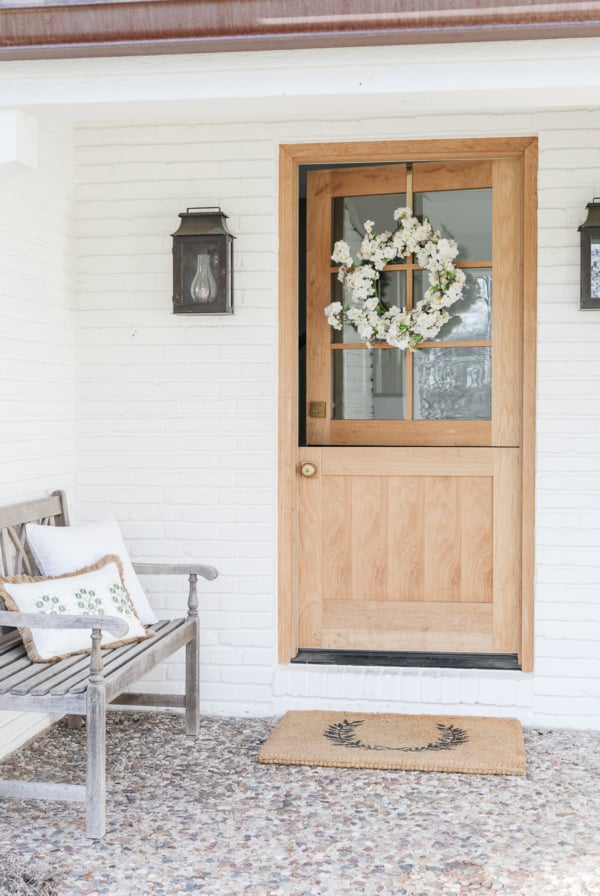






Hi, Julie! I bought a lavender tree a couple weeks ago. The care info said that it blooms all summer and should be deadheaded to encourage more blooms. It looks as if the first blooms are dying off. Having. I experience, I’m not even sure where to nil the buds off. Can you offer any advice? Thank you!
Hi Tracy,
I’m sorry I’m just now seeing your message!
You can dead head the blooms right above the first little set of leaves under the bloom itself. You’ll cut the stem right at that set of leaves and remove.
Good luck and enjoy!
Julie
this is my first time, I have a lavender tree, my ? is is it best to plant it on a large planter or a small one ,
Hi Connie!
I would plant it in a pot that is just slightly larger than the one that it came in. Loosen the roots a bit and add nutrient rich soil, and you’ll be all set!
Enjoy,
Julie
I bought a lovely petit lavender plant last spring and got a bit of flowering before it stopped for the summer. I live in NYC and it seems to have survived the winter quite well. My question is that I have not pruned this plant. Is it too late to do that this season? If not, how would you suggest I conduct this pruning. Thanks so much for your help and advice 🙂
I live in Sanford Michigan and brought my tree in for the winter. But I am not sure what to do to keep it alive. Can I prune it this time of the year?
Purple flowers on my standard topiary tree have dried out & black. I do see a little Purple head on one stem. What do I need to do to revive this plant. It was placed in a slightly larger size pot than what it was in.
Hi JoAnna,
Be sure to remove all the dead flowers to encourage new growth. Make sure you have great drainage and add a little garden lime to help with the PH.
I hope that helps!
Enjoy,
Julie
How do I plant lavender for a lavender tree. I have a tree but do not know anything about what to plant to get more. I live in Lebanon TN so I realize that I will have to bring it in but at the same time would love to grow one. I did cut off the blooms and keep them.
Hi Penny,
I’ve always bought my lavender trees in the topiary shape already.
I’m not an expert on trimming them correctly to form a topiary, but best of luck to you! Enjoy your lavender!
Julie
My tree is round not leggy. I’ve pick off all the dead flowers….it DOES suck up alot of water. I had it out all summer. What zone is NJ in?
There a few grey like leaves, what do I do with them? Do I also cut or pinch them off?
Thank you in advance.
I brought my healthy lavender tree inside for the winter WI. I have never trimmed it, even during summer months. Now branches are looking sad near the stem and it has new green growth at the tips. How far back can I trim it to keep shape and allow it to blossom again one day. I would like to cut it way back so branches will look more healthy.
I absolutely adore Lavender. It’s fragrance is intoxicating and, the flowers are my favorite color. I would love to have a Lavender Tree but, I have some trepidation about the trunk. Is it as fragile as it looks? Is it okay to stake it up to give it substantial support? Do they really have only a 4 to 5 year lifespan?
HOW CAN I REPRODUCE LAVENDER TREE WITH THE BUDS COULD YOU TELL ME WATH TO DO WITH THOSE BUDS THANK YOU.